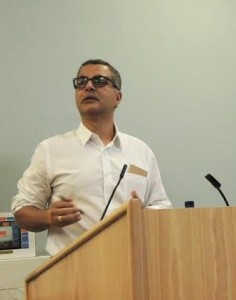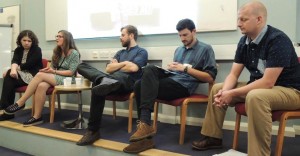by Alexander Williamson
11 July 2014
Around fifty academics, students and interested readers hunkered down for Colours of Memory: the first international conference to examine twenty-five years of Geoff Dyer being a living, breathing and – more importantly – published writer. The purpose: to use an academic context to reframe Dyer’s work, focusing on his key texts as exploratory avenues to contemporary debates in literary and photographic criticism. The entire event gained an extra dimension as Dyer, fresh off the plane from Los Angeles, attended it from start to finish.
To read Dyer’s work academically might be no easy task, given his virtually patricidal relationship with – to paraphrase his own words – ‘unimaginative criticism’. In Out of Sheer Rage (1994) he writes: ‘it kills everything it touches. Walk around a university campus and there is an almost palpable smell of death about the place because hundreds of academics are busy killing everything they touch.’ Geoff Dyer’s interstitiality – his situation at the centre of a huge, invisible Venn diagram where the genre-zones of memoir, non-fiction and fiction overlap – has in itself conjured a new genre in response to the fusty failings of academia: ‘creative criticism’.
Conference organizer Dr Bianca Leggett, working with Joseph Brooker of the Centre for Contemporary Literature, was tasked with weaving together the disparate interests, influences and texts of a writer whose obsessions are myriad and highly idiosyncratic. Look up the dictionary definition of ‘unpigeonholeable’ in the OED, and there you will find a picture of Geoff Dyer – possibly as a child cowboy playing at John Wayne. This difficulty, Bianca noted dryly, even extends to how best to address the author. ‘Geoff’, she suggested, could refer to the guest in the room, ‘Dyer’ to the author of the work. Bianca’s call for papers had deliberately invited reflections that explored new modes of presentation, and the results indeed moved fluidly between close reading, critical reflection, photographic display, personal memoir and comic turn.
Geoff/Dyer’s relationship to criticism was examined in opening address by Amitava Kumar of Vassar College, NY. Drawing an ‘imaginative line’ from D.H. Lawrence to Dyer, Professor Kumar called upon the delegation to think ‘like a Geoff Dyer fan’ and present papers in a ‘slacker style’ befitting the occasion. Colloquialisms, Kumar urged, should be permitted, alongside strictly non-academic behaviour such as informality, overfamiliarity and general fawning over the author.
Lines, imaginative or otherwise, provided a guide for several of the conference papers. In the opening panel, Alexander Williamson’s cocaine-confession paper examined depictions of drug use in contemporary British fiction, with Dyer and Alan Hollinghurst sharing a figurative line or two. One-liners, quips and complex jokes informed Jonathan Gibbs’ paper on the bathos-pathos divide in Dyer’s self-satirising writing. This session sparked a detailed discussion of Englishness, and what it meant to be an English writer in the postcolonial, post-9/11 world.
Given the American influences and recurrent obsessions apparent in Dyer’s work, other ‘imaginative lines’ came play: those of the vernacular, or the cross-cultural and interdisciplinary dialogues continually at work in his writing. Tom Overton discussed the anxiety or ecstasy of ‘influence’ through the relationship between Dyer’s texts and John Berger’s, likening it to a perpetual game of mutually agreeable ping-pong. Three presentations were particularly unconventional by regular academic standards. Shreepad Joglekar had travelled from Kansas State University via Mumbai to present a slide show indicating the influence of Dyer’s The Ongoing Moment (2005) on his own photography, bringing him into the orbit of precursors Barthes, Berger and Sontag. Joglekar’s video piece Vita Contemplativa was screened for delegates to watch during the day. Elizabeth Minkel, a columnist for The Millions and the New Statesman, recounted episodes from her own life, exploring how Dyer’s study of jazz, But Beautiful (1991) had changed her own working relations to music and writing. Matthew Harle recounted his authorship of an as yet unperformed puppet opera. Connections emerged between the unfinished work of art and what James Wood, reviewing Dyer, has called ‘negative liberty’: creativity as task-avoidance, or the productive process of doing the exact opposite of what you should be doing.
The final panel considered the evolution of Dyer’s work in the 25 years since the publication of his debut novel The Colour of Memory (1989, and now out again in a brand new US edition). Joseph Brooker returned to that novel’s treatment of time and its complication of narratorial identity. The historian Morgan Daniels considered Dyer’s work in relation to the 1990s, asking what the colour of the 1990s might be and opening up an alternate historical phenomenology. Both papers assessed the difficulties, complexities and creative possibilities of rendering the contemporary as history.
Dyer’s interest in military matters – evidenced from The Missing of the Somme (1994) to Paris Trance (1998), where two characters bond over a shared love of Second World War cinema – has found new culmination in his latest book, Another Great Day at Sea – Life Aboard the USS George H.W. Bush (2014). Bianca Leggett’s paper paid close attention to this new work, considering both Dyer’s text and the many photographic illustrations. As a continuation of the insider-outsider position that Dyer typically occupies, the author once more finds himself as at once a detached observer and an embedded journalist; craving solitude while seeking collegiate attachment; consciously a citizen of the global community and purveyor of US culture, yet remaining unmistakably an Englishman to his American naval companions.
A reading from the text by the author was followed by an extensive interview conducted by Bianca, and questions from the audience. In characteristically amusing and often self-deprecating fashion, Geoff/Dyer took the opportunity to debunk a few myths – not least about the gap between himself and his fictional persona, saying ‘there’s a lot of traffic between the real and invented’; that he believes his work to be ‘not nostalgic but elegiac’; that he is ‘an obsessive person, but not addictive’. Like Lawrence, he believes he remains ‘an Englishman even in the teeth of England’. Dyer’s travels have lately led him to the United States: first as a visiting professor on at the University of Iowa’s nonfiction writing programme, now to a new residence in California. As an Englishman in the teeth of America, one cannot help but wonder if the errant son of ‘unimaginative criticism’ is about to produce his finest work.



Recent Comments